The Green Dragon Crescent Blade: A Warrior’s Journey
As I delve into the rich tapestry of history, certain legendary weapons beckon with a magnetic allure, drawing me into their captivating tales of valor and martial skill. Among these, the Green Dragon Crescent Blade shines like a beacon, embodying the very essence of martial mastery and courage.
It’s more than a mere weapon; it’s a symbol deeply embedded in Chinese culture, resonating with the stories of mighty warriors and the enduring legacy of their prowess. Join me on this thrilling exploration into the heart of the Green Dragon Crescent Blade, where we’ll uncover its origins, discover the formidable hands that once held it, and even learn where one might acquire a replica, allowing us to grasp a tangible piece of this martial history.
What was the Green Dragon Crescent Blade?
The Green Dragon Crescent Blade, known in Chinese as the Qīnglóng yǎnyuèdāo, is an iconic weapon that transcends the pages of history, brought to life through the legendary Chinese general, Guan Yu, in the 14th-century epic novel, Romance of the Three Kingdoms. This formidable weapon is classified as a guandao, a traditional Chinese polearm known for its imposing presence on the battlefield.

But what truly sets the Green Dragon Crescent Blade apart is its evocative alias—the Frost Fair Blade. This name originates from a chilling yet mesmerizing legend. During a fierce battle amidst the unforgiving snow, the blade’s edge became anointed with the blood of adversaries. The biting cold of the battlefield froze this blood into an icy sheen, forming a spectral layer of frost that adorned the blade.
In the intricate narrative of Romance of the Three Kingdoms, the Green Dragon Crescent Blade’s genesis is woven into a tale of valor and alliance. A local blacksmith, with steel generously sponsored by the benevolent merchant Zhang Shiping, forges this magnificent weapon.
As history unfolds, the blade changes hands, passing from the heroic grasp of Guan Yu to Pan Zhang, a recipient of Sun Quan’s appreciation for capturing Guan Yu. The turning tides of fate, however, see Guan Yu’s son, Guan Xing, seize the blade back from Pan Zhang during the climactic Battle of Yiling. It then embarks on a timeless journey, handed down through generations within the esteemed Guan family.
Yet, as captivating as this legend is, there lingers a veil of historical ambiguity. Whether Guan Yu ever brandished the Green Dragon Crescent Blade or if it was a product of myth remains a subject of debate. Authentic historical texts from his era remain conspicuously silent about the weapon’s existence. Skepticism persists, primarily because the guandao, a weapon of its kind, didn’t see widespread use until the Song Dynasty, long after Guan Yu’s time.
The weight of myth further obscures the blade’s reality. In Chapter 1 of Romance of the Three Kingdoms, it’s stated that the Green Dragon Crescent Blade weighed a staggering 82 catties. To put this into perspective, during the Eastern Han Dynasty and the Three Kingdoms period, one catty equated to approximately 220 grams.
Thus, the legendary blade would have weighed around 18 kilograms, a colossal 40 pounds. In modern times, a weapon purporting to be the Green Dragon Crescent Blade, weighing about 44 kilograms (97 pounds), is exhibited at China’s revered Purple Cloud Temple.
Who Wielded the Green Dragon Crescent Blade?
Guan Yu was born in Xie County, Hedong Commandery, which corresponds to present-day Yuncheng, Shanxi. His original courtesy name, Changsheng, signified his scholarly inclinations and deep interest in ancient texts, particularly the historical work Zuo Zhuan, from which he could fluently recite passages.
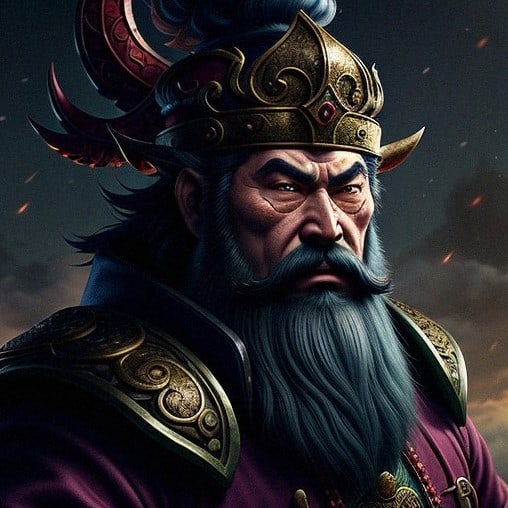
His journey into heroism began when he left his hometown, reasons shrouded in mystery, and ventured to Zhuo Commandery. It was there that the flames of destiny ignited with the outbreak of the Yellow Turban Rebellion in the 180s.
Alongside his valiant comrade Zhang Fei, Guan Yu joined a volunteer militia organized by Liu Bei to quell the rebellion, fighting under the command of Colonel Zou Jing. Renowned for their stalwart strength, Guan Yu and Zhang Fei emerged as formidable warriors.
The bond between Liu Bei, Guan Yu, and Zhang Fei transcended mere comradeship; they were akin to brothers. Their unwavering loyalty and unity were palpable in every facet of their lives, from sharing the same room and mat to partaking of meals from a common pot. This extraordinary brotherhood extended to their roles as guardians, ensuring Liu Bei’s safety amidst crowded gatherings and vigilantly standing sentinel during lengthy meetings.
Guan Yu was celebrated not just for his martial prowess but also for his benevolence towards his soldiers. His loyalty to Liu Bei, akin to familial devotion, was unwavering. However, his attitude toward the gentry was starkly different, marked by a lack of courtesy and respect.
The journey of Guan Yu and Liu Bei took them to Xu Province after triumphing over Lü Bu in the Battle of Xiapi in 198. This alliance was short-lived, as about a year later, Liu Bei, under the pretense of aiding Cao Cao in an attack on Yuan Shu, made his move. Liu Bei assassinated the provincial inspector Che Zhou and claimed control of Xu Province, entrusting Guan Yu with the capital, Xiapi.
In 200, Cao Cao retaliated, prompting Liu Bei’s flight to northern China, where he sought refuge under Cao Cao’s rival, Yuan Shao. Guan Yu, however, found himself in Cao Cao’s custody and was treated with respect. Cao Cao recognized Guan Yu’s prowess and asked Emperor Xian to appoint him as a Lieutenant-General.
The tides of history churned further when Yuan Shao dispatched General Yan Liang to attack Cao Cao’s garrison at Boma. Cao Cao called upon Guan Yu, alongside Zhang Liao, to lead the vanguard in a decisive confrontation. In the heat of battle, Guan Yu, recognizing Yan Liang’s distinctive parasol, engaged him, ultimately beheading the formidable general. This act of valor earned him the peerage of “Marquis of Hanshou Village,” as bestowed by Emperor Xian.
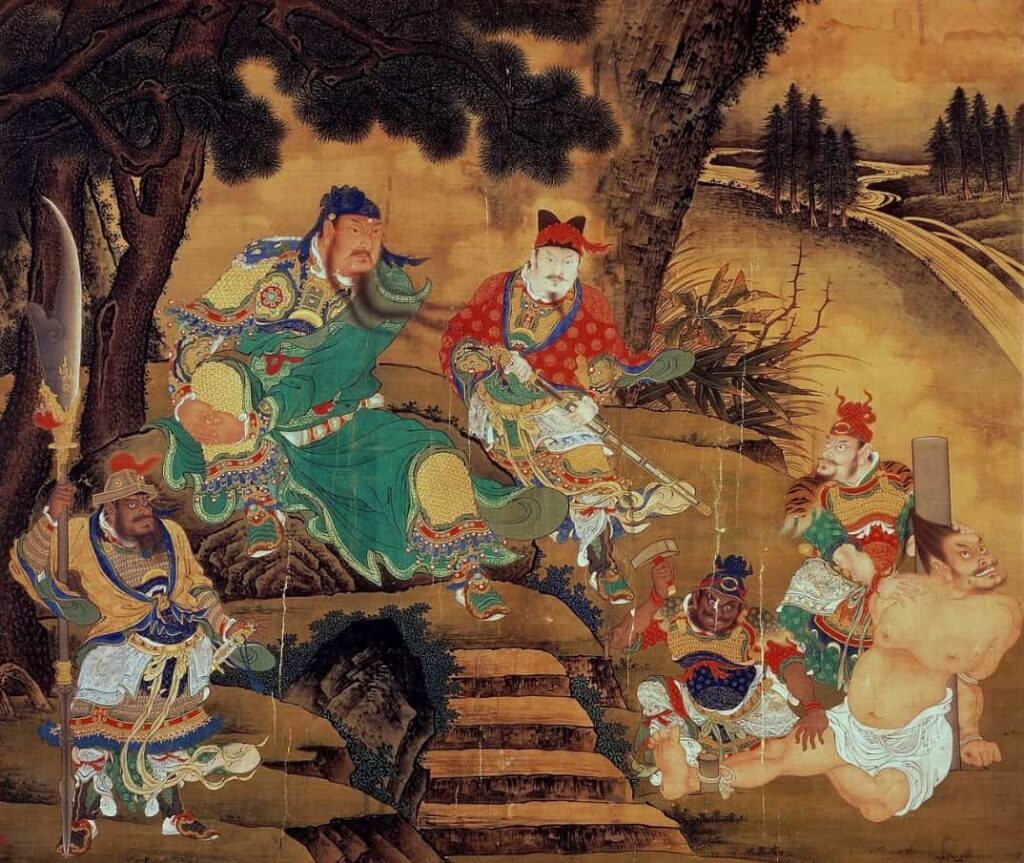
While Cao Cao admired Guan Yu’s character, he sensed the general’s imminent departure. A conversation between Guan Yu and Zhang Liao revealed that Guan Yu’s unwavering loyalty to Liu Bei surpassed any favors received from Cao Cao. This departure was foreseen, and Cao Cao held deep respect for Guan Yu’s righteousness.
After his legendary feats, Guan Yu left Cao Cao’s camp with a heart full of gratitude, returning to the fold of Liu Bei, who, by then, had forged an alliance with Sun Quan. Yet, despite his valorous deeds and unquestionable loyalty, Guan Yu’s life took an unexpected turn when, in 208, a territorial dispute between Liu Bei and Sun Quan erupted in southern Jing Province.
Guan Yu as Seen in Dynasty Warriors
In the Dynasty Warriors video games, Guan Yu is portrayed as a formidable and virtuous general, revered as a hero within all the Three Kingdoms. His journey begins during the Yellow Turban Rebellion, where he crosses paths with Liu Bei and becomes a stalwart ally in the struggle for justice.
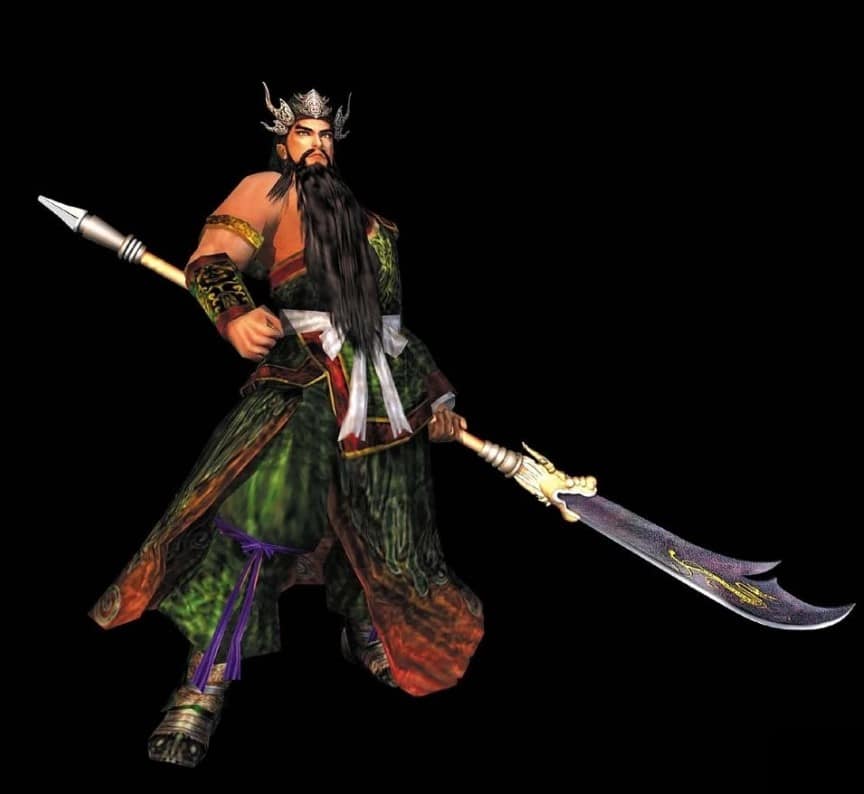
Together, they confront the chaos of the era, and their bond is further cemented by their oath to each other. One of the iconic moments in Guan Yu’s depiction is the famous duel at Hu Lao Gate, where he and his brothers face off against the formidable Lu Bu.
Despite their heroic exploits, Guan Yu occasionally finds himself in the service of Cao Cao, often driven by circumstances that temporarily separate him from his brothers. This period is marked by conflicting loyalties, as Guan Yu is torn between his oath to Liu Bei and his sense of gratitude towards Cao Cao for his kindness. Nevertheless, he ultimately reunites with Liu Bei, reinforcing their unwavering brotherhood.
Guan Yu’s character also emphasizes his role as a guardian, whether it’s protecting Liu Bei’s escape during the Battle of Chang Ban or safeguarding Jing Province when his brother is away. Tragically, many scenarios depict his demise at Fan Castle while defending Jing Province. These games delve into his complex character, his commitment to honor, and his unwavering loyalty to his oath brothers, Liu Bei and Zhang Fei.
Guan Yu Gameplay
In Dynasty Warriors 9, Guan Yu’s playstyle revolves around his signature weapon, the crescent blade. He possesses a set of unique attacks and abilities that make him a formidable warrior on the battlefield:
- Unique Flow Attack Finisher: Guan Yu’s finisher involves him twirling his crescent blade overhead, creating a tornado effect that launches enemies into the air.
- Unique Trigger Attack: By pressing R1 and Triangle, Guan Yu delivers a slanted rotating swipe that can lift nearby enemies off their feet, setting them up for an aerial flow attack.
- Special Technique: Activated with R1 and Circle, Guan Yu reaps his blade forward to the lower right, leaving behind a trail of dark red streaks. This move is reminiscent of his second EX attack from previous installments and is imbued with the slash element.
- Musou Attack: Guan Yu’s Musou Attack is executed by pressing Circle. He unleashes several spinning outward slashes while moving forward. The attack concludes with Guan Yu stroking his beard and delivering a fiery diagonal slice, creating a fire tornado that engulfs nearby foes.
- Aerial Musou Attack: Performed by pressing X and Circle, Guan Yu spins in mid-air before striking the ground with a fierce vertical slash, generating a pillar of lightning that sends groups of enemies flying. This move is based on his Ascending Dragon Musou Attack from previous titles.
Additionally, Guan Yu can utilize his horse on the battlefield with various horse maneuvers, including summoning the horse, auto-running, sprinting, jumping, and executing fast attacks and trigger attacks while mounted. His horse can also perform a Musou Attack, consuming Musou instead of stamina.
Furthermore, Guan Yu has access to a bow for ranged combat. In shooting mode, he can pull out his bow and take an archery stance, allowing him to switch between different types of arrows. He can fire arrows at targets, lock onto them, and lower his bow when needed.
Where Can I Get a Green Dragon Crescent Blade Replica?
Samurai Swords Store
1095 Carbon Steel Guandao Yanyuedao

Features:
- Blade Material: 1095 Carbon Steel for durability and authenticity.
- Sword Type: Guandao, perfect for traditional martial arts and historical re-enactments.
- Impressive Dimensions: 58 cm blade length, 150 cm handle length, and a weight of 6 kg for a commanding presence.
1060 Carbon Steel Guandao
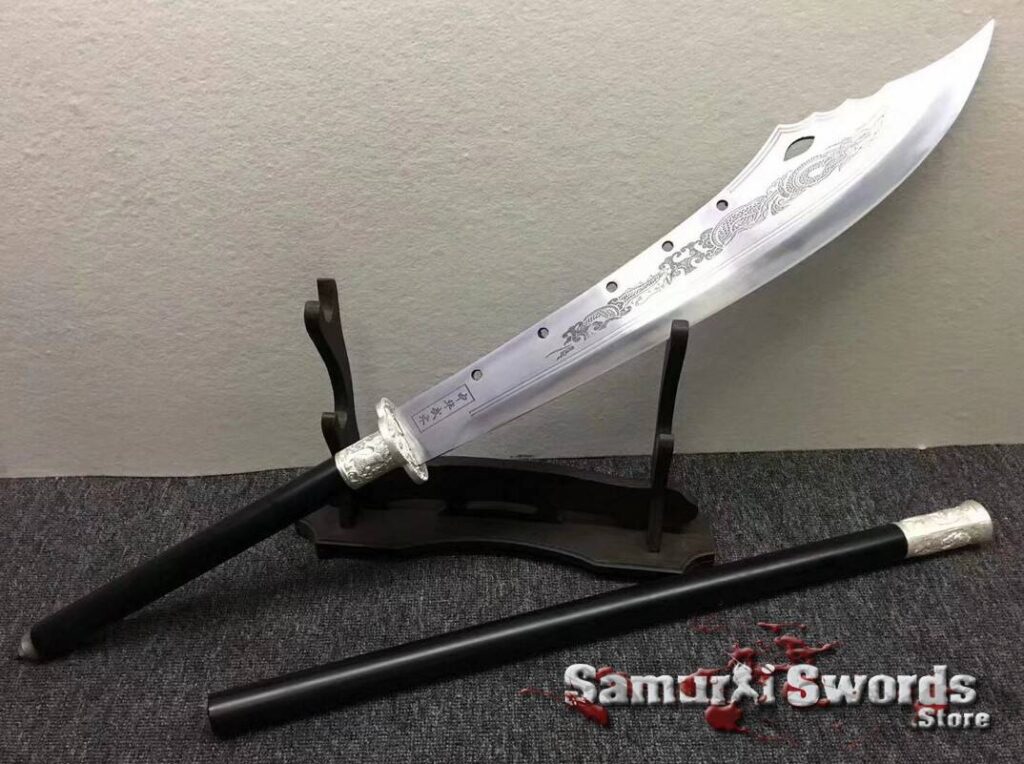
Features:
- Blade Material: Forged from high-carbon 1060 steel for a sharp and durable edge.
- Blade Design: Curved blade optimized for sweeping and slicing motions, reflecting its historical battlefield lineage.
- Dimensions and Weight: Blade length of 55 cm, handle length of 110 cm when fully assembled, with a blade width of 6 cm and a weight of 3.5 KG.
1060 Carbon Steel Guandao

Features:
- Blade Material: Crafted from 1060 Carbon Steel, providing durability and strength.
- Traditional Design: Modeled after the ancient Guandao, combining grace and power in its 45 cm blade and 79 cm handle.
- Metal Accents: Features metal Tsuba (handguard), Fuchi (hilt collar), and Kashira (pommel) for an authentic martial arts aesthetic.
1095 Carbon Steel Guandao with Antique Flower Acid Pattern
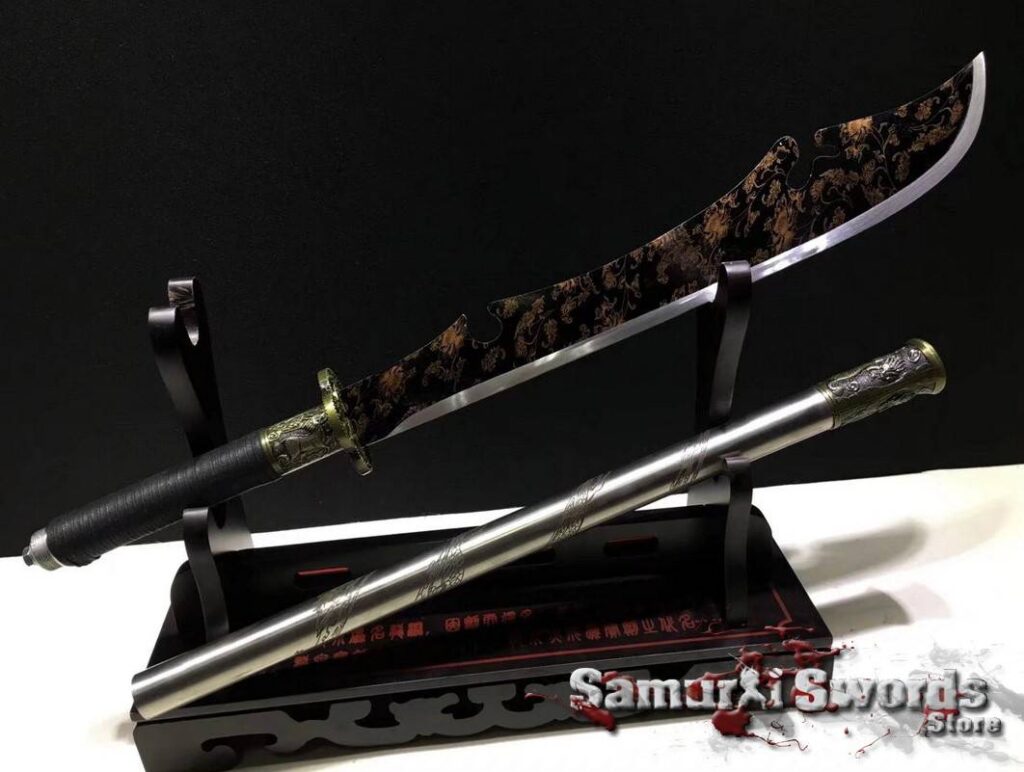
Features:
- Blade: Intricately engraved 1095 Carbon Steel Guandao with Antique Flower Acid Pattern.
- Dimensions: Blade length of 50 cm, 8 cm blade width, and a full tang design for durability.
- Design and Accessories: Features a metal Tsuba (handguard), Fuchi (hilt collar), Kashira (pommel), and a stainless steel scabbard for protection, all presented in a silk sword bag.
Conclusion
In my quest to understand the essence of martial valor and the pursuit of perfection, the Green Dragon Crescent Blade emerges as an emblematic symbol. Its graceful curve and storied history reflect the indomitable spirit of the warriors who wielded it, showcasing the artistry and significance of traditional Chinese weaponry.
Their tales of courage and heroism resonate through time, inspiring a deeper appreciation for the rich heritage behind iconic weapons. Exploring its legacy has also piqued my interest in the broader types of Chinese swords, offering insight into the cultural and historical context that shaped such legendary artifacts. As we conclude our journey through both myth and reality, the Green Dragon Crescent Blade remains etched in my heart as an enduring symbol of power, grace, and the unwavering spirit of the warriors who elevated it to legendary status.
